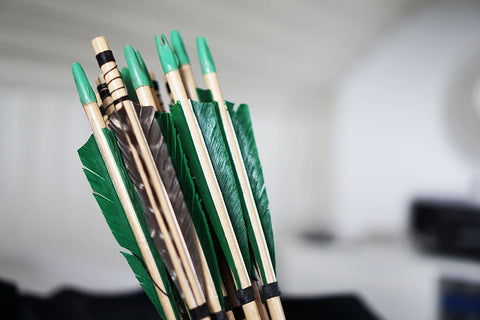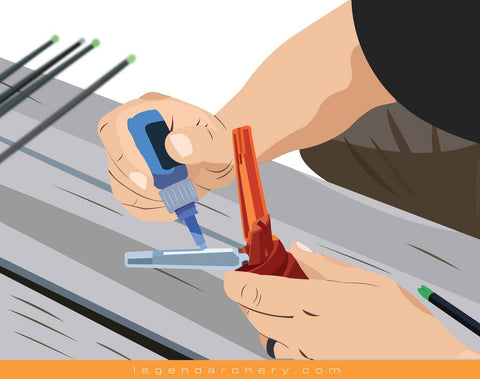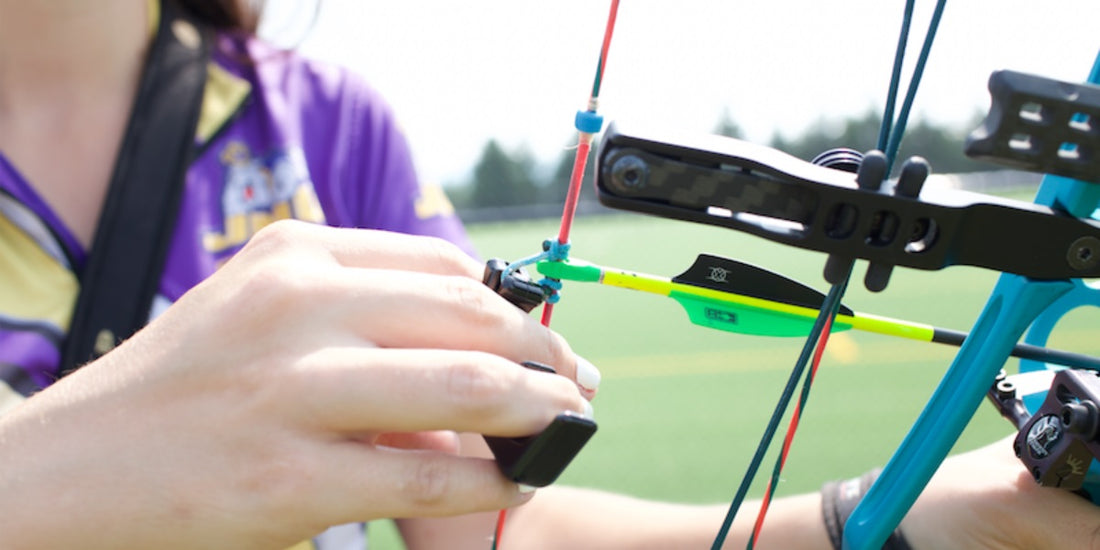Arrow fletchings are a relatively small part of your entire bow setup, but they play a critical role in ensuring you can hit the target when you fire. You can think of fletchings as a tool that helps steer arrows to their intended destination, just like the steering wheel does for a car.
To be fair, an arrow can be shot without fletchings. However, you will find that these components help to ensure proper shooting accuracy and provide a sense of direction that your arrow desperately needs.
So, what are arrow fletchings, and why are they so crucial to archery? In this piece, we’ll examine the different fletch options, as well as the pros and cons that you can expect from each.
Arrow Fletchings - What Are They?

In its simplest sense, an arrow fletching is a component that helps you to stabilize your arrow while in flight, providing the required precision to reach its intended destination. This, in turn, boosts the arrow's overall speed, accuracy, and impact power.
For an arrow to fly sharply through the air, its back end must properly follow its front. The fletch ensures this happens, keeping the entire arrow in proper alignment as it moves through the air and toward the target. And, if the arrow’s body threatens to move out of alignment, the fletch keeps it in line and ensures proper movement.
Even the most experienced archers can make mistakes with directing and aiming when shooting, especially in high-pressure situations. Arrow fletchings help correct these errors as much as possible, providing a simple and effective way for the arrow to travel straight and hit its target.
As explained earlier, an arrow can be shot without fletchings. However, considering that the entire purpose of archery is to optimize accuracy, fletchings are a critical accessory that you would need to have as an archer.
Options For Arrow Fletchings
When it comes to arrow fletchings, you have the freedom of variety. You can choose whichever option works better for you since there are so many materials, shapes, and sizes. Generally, the option you choose will depend on what you need exactly.
Nevertheless, the primary options available when it comes to fletchings are feather fletchings or vane fletchings. Standard arrow fletchings come with three vanes or feathers; two of them - known as the “hen” vanes or feathers - will help to create a flat path against the arrow riser. Then, the third - known as the “cock” vane or feather - will point the arrow away from the riser when the arrow has been nocked. Most manufacturers differentiate the cock vane or feather from the hens by painting it in a different color.
Below, we’ll examine the two prominent fletching materials:
Vane Fletchings

Vane fletchings are the most popular option and are widely used for most forms of archery. They are usually made of soft plastic or vinyl materials, which are attached to the arrow shaft using a fletching jig or fletcher.
A vane fletching usually comes in a broader range of sizes and shapes than the feather variant. If you use a vane fletching with a broader surface area, you will find that it can be heavier and even slow the arrow after you’ve fired it. On the flip side, broader vane fletchings tend to be better when it comes to adjusting the flight path of a poorly shot arrow.
Slimmer vane fletchings have higher stability levels and can also cut down on wind drag when the arrow is released. However, if you still shoot the arrow with bad form, the fletching’s ability to correct the arrow’s movement will be reduced significantly.
You should also note that vane fletchings are much better if your arrow rest is elevated. You get much better arrow clearance - basically, the arrow’s ability to move from the bow without the fletchings making contact with the latter.
Finally, you get the benefit of versatility in terms of weather. Whether you’re shooting in the sun or a windy location, a vane fletch will easily hold its own.
Feather Fletchings

Feathers are the oldest material used to make arrow fletchings. Feather fletchings are usually up to three times lighter than vane fletchings. This means that they are more flexible, offering an even greater boost when it comes to overall arrow speed. Combined with their optimal steering capabilities, you’ll find that feather vanes are usually the better option for beginner archers, particularly those who enjoy long-distance shooting. A feather fletch will fold in the air when the arrow is fired, making it more forgiving as the arrow is in motion.
That said, feather fletchings have some downsides too. They create more drag on the arrow and are more prone to damage than vane fletchings. They also don’t do so well in windy or rainy weather as they can get really waterlogged that they just lay flat when the arrow has been released.
Related: Flu-Flu Arrow
Arrow Fletchings - The Different Orientations
Now that we’ve discussed the primary types of arrow fletchings let’s look at the orientations. Fletching orientation discusses the positioning of your arrow fletching materials, which has a significant effect on the eventual direction of the arrow as it leaves the bow. There are different orientation styles when it comes to arrow fletchings. These include:
Straight Fletching

The straight orientation keeps the arrow fletchings straight and aligned with the arrow shaft. This orientation doesn’t create any arrow rest problems, which allows for the swiftest arrow flight and is especially effective for close-range shooting.
However, straight fletchings aren’t always perfect. Their biggest downside is the fact that they don’t create any spin. And considering that spin helps to provide greater levels of stabilization and accuracy for shooting, straight fletchings are ideal for short-distance shots.
Straight fletches are also easily affected by wind. So, while you enjoy additional speed, you need to bear in mind that these fletchings are highly vulnerable to wind drag.
Offset Fletching

The offset orientation is similar to the straight one since your fletch is straight on the shaft. However, the fletch is slightly turned from front to back to support rotation during flight without compromising on clearance. This provides additional stability, especially with broadheads, and is perfect for long-range shots.
An offset fletch will also create additional spin, which makes the arrow better stabilized and able to maintain a true flight path as it travels from the bow. The extra spin also means that the arrow won’t be affected so much by the wind as it will easily steer the shaft.
The only downside to an offset fletch is that it picks up more air resistance while in motion resulting in a minimal loss of arrow speed. Still, as long as your arrow hits its mark, you need not worry much about a loss in velocity.
Helical Fletching

If you’re looking to optimize accuracy, particularly with long-range shots, then the helical fletch is what you want to go for. These fletchings come with slight curves to support in-flight rotation and can be set to either the left or right side.
Similar to bullet rotation effected by a gun’s riffling, the helical fletch provides optimal rotation, which quickly stabilizes your arrow and creates the right amount of spin. Aerodynamically speaking, helical fletches are your best bet for straighter and more stable flights, even in windy conditions.
However, loss of considerable speed is an issue with helical fletchings as well as clearance problems.
How to Fletch An Arrow
Finally, let’s take a quick look at the arrow fletching process. While you can always get already-fletched arrows from a manufacturer, learning to fletch arrows yourself will save you a lot of stress going back and forth to the archery shop each time a vane gets damaged or falls off. To fletch an arrow, you’d need the following:
- The arrow shaft
- The fletching jig
- Your fletching material
- Rubbing alcohol
- Fletching glue
Once you get the materials needed, follow these steps:
-
Select your fletching:
The first step will be to pick the right fletching for you. As explained earlier, you can choose between feather or vane fletchings in your preferred sizes, colors, and shapes.
-
Set up your jig:
To attach the fletch to the shaft, you’ll need a jig. The function of a fletching jig is to align each fletch in a precise and consistent location. It comes with a base that holds your arrow shaft and a clamp that attaches the fletch to the shaft. Take some time to read the instructions on the jig to understand how to set it up.
-
Prep your shaft:

You will need to prepare your shaft by cleaning them with some rubbing alcohol. This removes any dirt or film that can hamper bonding or prevent the glue from setting when applied.
-
Stick the fletch:
With your shaft prepared, you’re ready to fletch your arrow. Place the arrow shaft in the jig and put a fletch in the jig’s clamp.

Then, apply a thin film of glue along the fletch’s length.

Place the clamp on the jig, and apply some pressure to allow the fletch to sit perfectly against the shaft.

Leave the glue to dry and pick up the next arrow shaft to be fletched.
Boom! You’re done!

Conclusion
Arrow fletchings rarely ever get the love they deserve. However, these unsung heroes go a long way in helping you to achieve optimal accuracy when you shoot. They act as the “rudder” that drives the direction of your arrow and help stabilize it if, by chance, there are errors in your shot execution process. Hence, just as you take your time to choose the right arrow, you also need to be deliberate about your fletch.
As an archer, it’s important to remember that there’s no one-size-fits-all approach to owning an arrow fletch. You want to consider things like the fletch’s material and orientation, as well as what you’re trying to get out of the arrow. With the guide above, you should be able to get started with arrow fletchings.
You might also like: Different Types of Arrows and Uses
 cust@legendarchery.com
cust@legendarchery.com 302 503 5767
302 503 5767 Sauk Village IL 60411
Sauk Village IL 60411


